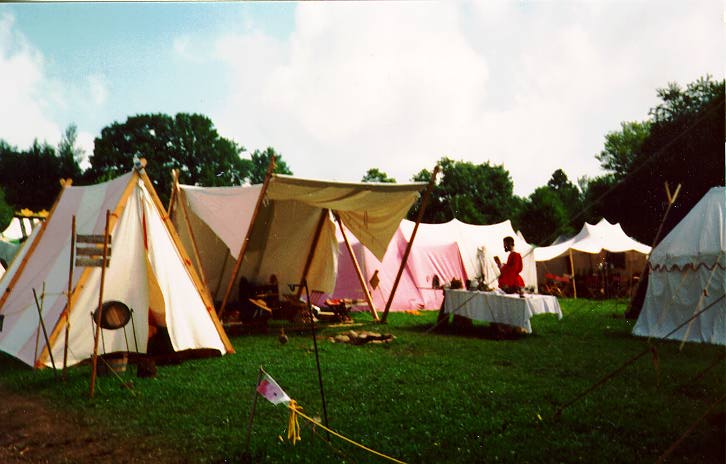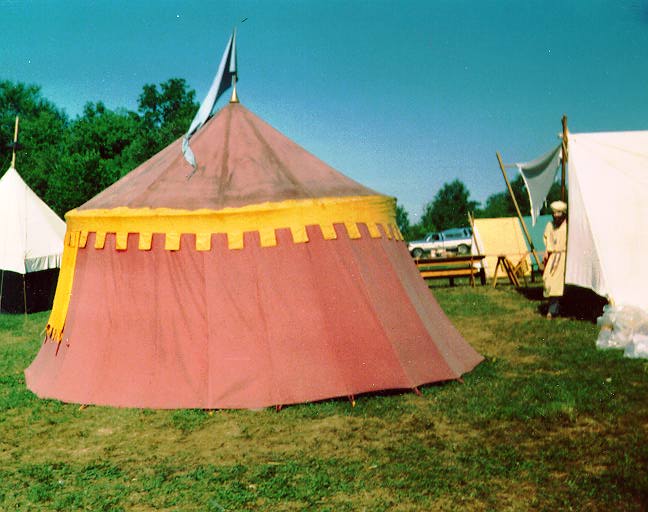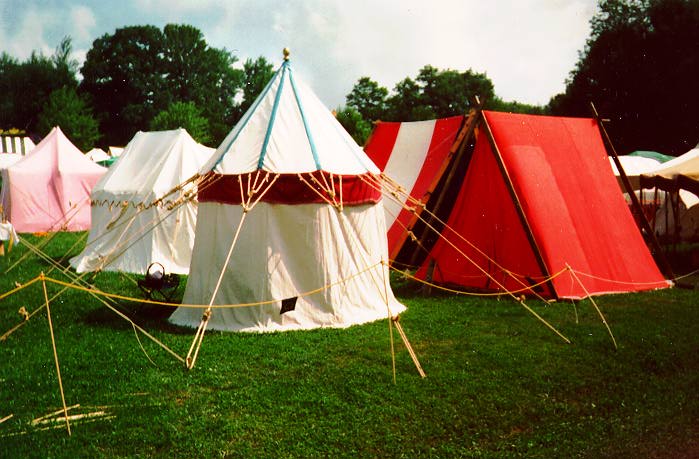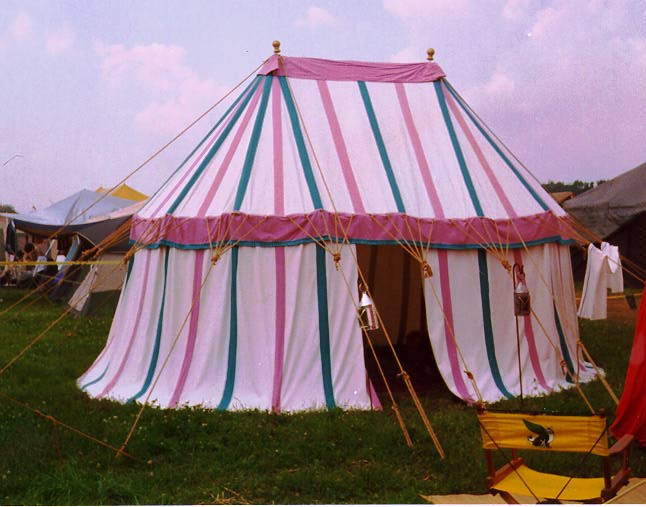Deborah and Steve's Plausibly Medieval Pavilions
This page began as a way to show off the pictures we (Deborah
Peters and Stephen Bloch)
had taken of various reconstructed
medieval pavilions we've lived in and/or built. But
I anticipate it becoming also an impetus to discussion of various designs
for medieval tents, how to build them, how to live in them, etc.
Accordingly I've put in
a Taxonomy of Tent Designs
discussing different structures and construction methods,
a collection of medieval pictures of tents
useful as iconographic evidence,
a custom tent measurement calculator,
and links to as many
other relevant Web sites as I could find.
If you find bugs in the calculator,
if you know of other sites I should link to,
or if you can contribute good pictures or descriptions of reconstructed tents,
please e-mail me.
Note: we are not in the business of building and selling
pavilions.
We do not have a catalogue, we do not have a price
list, we do not have a mail-order policy, etc.
I'll be happy to provide suggestions and moral support from my
experience and that of other tentmakers I know, should you be
inspired to build your own, but I will not build your tent.
Many of the pictures on these pages are shown in "thumbnail"
format, linked to larger versions of the same picture. So if a particular
picture piques your curiosity and you want to see more details, try
clicking on it.
The SCA, Living History, and Historical Accuracy
We originally developed our interest in this area through our
participation in the Society for Creative
Anachronism, a medieval hobbyist organization whose tens of
thousands of members cover a vast spectrum of historical accuracy and
interests. At the "high-accuracy" end of this spectrum are
people doing academically credible, museum-quality research and
reconstruction. Other members are more interested in sword-fighting
(as a sport, not a research area), flirting, and drinking homebrew (not
unworthy aims in themselves -- I've tried a little of all three).
More recently, we've been participating in La Belle Compagnie, a
Hundred Years War living-history group.
Anyway, this Web site aspires to the "high-accuracy" end: I'm
interested in how tents were actually built and used in the Middle
Ages, and how to reconstruct them today.
The Pennsic War
Many of the photographs on this site, and much of the testing
experience of the tents discussed here, are from the Pennsic War.
This largest event of the SCA year is held in western
Pennsylvania in early to mid-August, and attracts approximately 10,000
participants (from both the SCA and other medievalist groups),
some of whom stay for as long as two weeks. At this event,
and at numerous smaller and briefer events, most participants sleep in
tents or pavilions of some sort, varying from blue plastic tarps to high-tech
backpacking tents to careful reconstructions of actual medieval tents.
Tent Class at Pennsic
We held a panel discussion of tentmaking techniques at Pennsic
1997, with a one-hour field trip to examine the participants' own efforts.
Interest was high, and the level of expertise of the participants varied
from Myfanwy, who'd built one pavilion, to us, with two, to Mistress
Barbary, at several hundred, to the people from Medieval Miscellanea and
Tentmasters, who had built and sold thousands. I was somewhat
surprised that so few people showed up wanting to show off their own
efforts on the field trip.
A similar class has been held at Pennsic each year since. Each year the
number of participants, and the number of pavilions to visit, has grown, and
the field trip has stretched to three hours (for the die-hards who last
that long).
Note to participants in past classes: I saw a number of you
taking photographs, both full-view and detail, of the tents we visited.
If anyone would like to contribute photographs to this Web site, I'd
be very grateful; please contact me at
sbloch@adelphi.edu.
Enchanted Ground
 Deborah
and I have for a number of years been part of the
Enchanted Ground camp at Pennsic.
Enchanted Ground, founded by Duke Cariadoc
of the Bow, is based on the conceit that, due to some sort of enchantment,
this patch of ground is no longer a part of the twentieth century but rather
of the Middle Ages. Inside it there is no discussion of things that didn't
exist in the Middle Ages, and we avoid obviously modern camp gear:
cooking equipment, bedding, clothing, and (most relevantly to this page)
housing such as tents.
Deborah
and I have for a number of years been part of the
Enchanted Ground camp at Pennsic.
Enchanted Ground, founded by Duke Cariadoc
of the Bow, is based on the conceit that, due to some sort of enchantment,
this patch of ground is no longer a part of the twentieth century but rather
of the Middle Ages. Inside it there is no discussion of things that didn't
exist in the Middle Ages, and we avoid obviously modern camp gear:
cooking equipment, bedding, clothing, and (most relevantly to this page)
housing such as tents.

We didn't
build this one, we borrowed it from the (now-defunct) Gwyntarian Musicians'
Guild. Although its shape resembles those of various medieval tents, its
internal structure has no resemblance to any that I know of: it had a single
center pole, with about a dozen ropes going up the pole, through pulleys
or loops at the top, and down at an angle to the circular welded steel
hoop that held the shape of the shoulder. This hoop was stabilized by a
number of cross-braces (also welded steel, with lots of wing-nuts), the
assembly and disassembly of which took hours of frustrating work and caused
injuries ranging from mild burns (from steel sitting in direct August sun
for hours) to bruises to badly pinched fingers. The main advantage of this
structure is that no guy-lines extend beyond the footprint of the tent.
Our first King Rene tent

At some point Deborah decided to build her own pavilion based on the many
pictures of pavilions in King
Rene d'Anjou's Book of Love, aka Le Cueur d'Amours Espris. We
completed this pavilion as a joint project in 1994, aided by the
Calon
Scrolls special issue on pavilions. (The
Calon
Scrolls is the arts-and-sciences newsletter of the
Kingdom of Calontir,
which has something of a reputation for pavilioning.)
More pictures (both of our pavilion and of those in King Rene's book) and
construction details are on another page.
Our second King Rene tent
 When
Deborah started building the first tent, she was single. By the time it
was finished, she and I had met and were considering marriage. We quickly
found the tent too small for both of us, a week's food, clothing, music,
and musical instruments. So we built a larger tent in 1996, based on the
pictures of oval pavilions in King Rene's book. More pictures, and discussion
of construction details, are on another page.
When
Deborah started building the first tent, she was single. By the time it
was finished, she and I had met and were considering marriage. We quickly
found the tent too small for both of us, a week's food, clothing, music,
and musical instruments. So we built a larger tent in 1996, based on the
pictures of oval pavilions in King Rene's book. More pictures, and discussion
of construction details, are on another page.
Oh, by the way, none of these tents, to my knowledge, has ever collapsed
or flown away in a Pennsic storm.
As I've paid more attention to pavilion design, I started trying to
organize the many different designs to keep them straight in my own
mind. The result is my Taxonomy of
Pavilion Designs; additions and corrections will be cheerfully
accepted! Look here for discussion of construction
techniques.
listed by source. If you have other such pictures, please
contact me!
These links include not only tents and pavilions, but yurts, sheds,
taverns, etc.
Disclaimer: I haven't assessed the quality of research going into all these
pages; I expect the reader to do that for him/herself.
Tanya Guptill (ska Mira Silverlock), another SCA member who builds pavilions,
has developed a page on
Medieval
Pavilion Resources, including lots of
on-line sources relevant to pavilion making, including a significant
amount on Mongolian yurts/gers.
She also hosts the
Sacred
Spaces Archive (Sacred Spaces is the newsletter of the Known World
Architectural Guild, and this site includes a number of articles on tents,
houses, and furniture).
Karen Larsdatter's period illustrations of
people setting up and taking down tents, and period illustrations
of market merchant booths.
See also her blog posts on sixteenth-century
tents and
fifteenth-century
tents. Lots of good links!
Mark S. Harris's collection
of Rialto articles on dwellings, with subcategories for tents, yurts,
castles, cities, thatched huts, carpentry, etc.
Stephen Wyley's Tents of History,
which includes a Database
of Tent References. Presented in table form, this massive collection
describes features and decorations of hundreds (at least!) of tents appearing
in pictures and textual references from the 1st to the 17th century C.E.
(Much of this information is also on a site in
Australia.)
Pavilion Information from House Greydragon. This is
apparently an SCA household that has built several pavilions on Daffyd's hub-and-spoke design (with some
modifications which they say help the spokes stay in place).
They also have a number of photos of a surviving
16th-century (???) pavilion in a museum in Basel, Switzerland.
Max and Mickel's Easy No-Bake Pavilion, a different
approach to building a circular tent. They point out that the design is
equally usable with external guy lines, vertical side poles, or the
hub-and-spoke construction. The page includes a lot of detail on the
practicalities of construction and set-up, e.g. what kinds of seams,
shopping list with prices, etc.
Panther
Pavilions, a commercial maker of medievalish pavilions.
Tentsmiths,
another commercial maker.
Past Tents, another commercial maker (in the U.K.).
Best known for their hub-and-spoke tents.
Four Seasons
Tentmasters, another commercial maker.
Dragonwing Pavilions,
another commercial maker; this site includes a number of interesting
articles about tent construction (and one about London Bridge!).
Building
a Conjecturally Period Pavilion, an old (1988) article from Cariadoc's
Miscellany. (The result is the black-and-white tent that appears next to
Marvin above, and next to our first tent in
this picture.)
The
Anglo-Saxon
Geteld
reconstructed by the
Norse Film &
Pageant Society
Charles McCathieNevile's
version
of the aforementioned Anglo-Saxon Geteld
Alexander the Lost's Griffin's
Den tavern, set up on site at Pennsic.
Devin O Raudh's wooden
shed.
Donna Hrynkiw's collection
of illustrations of medieval tents (also
flags and
banners).
Nils Hammer's A-frame
tent
Ted Reichardt's account of building a 14th-century English pavilion,
including some more primary-source pictures, discussion of materials and
vendors, design, etc.
(Ted used to go by the name of Svein Sveinssen in the SCA; now he's
Thomas somethingorother.)
Will McLean's blog
posts about medieval tent construction, including lots of medieval
illustrations, quotations and translations from tailors' manuals and
account books about tents, and photos of his own reconstructed round
tent (c1400 AD).
Mistress Ellisif Flakkari's
article on yurts and
gers
SCA
Arts & Sciences Page
Bibliography
I intend this section to eventually become a decent bibliography for
tent reconstruction. But for now, I'll just put in a few entries;
recommendations for others will be cheerfully accepted!
- Torvald Faegre, Tents: the Architecture of the Nomads.
This book discusses a variety of tents built by nomadic cultures around
the world: Bedouin and Berber tents in one chapter, Turkish black tents
in another, Mongolian yurts in another, North American tipis in another,
sub-Saharan felt huts in another, etc. Each chapter includes, if I remember
correctly, photos, measurements, drawings of distinctive construction details,
discussion of materials and why this particular tent design developed in
this particular culture.
- The
Calon Scrolls special issue on pavilions,
"Pavilions: History and Construction" by Baroness Barbary Elspeth
Ham and Countess Susannah Griffon, volume IV number 6.
The Calon Scrolls
is a regional newsletter of the Kingdom
of Calontir, the SCA regional chapter covering Missouri, Kansas, etc.
- "A Survey of Pavilions of the Known World", Alexandre le
BonHomme, ed. Compleat Anachronist number 26, July 1986.
(Individual articles by Susannah Griffon, Rognvaldr Buask, Briony
Blaaslagen, Seosaidh mac Seosaidh, Ceridwen Dafydd, Kathryn of Iveragh,
Hans von Steinhaus, and Luciana della Ridolfi.)
- Nomad Tent Types
in the Middle East, by Peter Alford Andrews. He's an academic whose
particular research interest is Middle Eastern tents; I've exchanged
some email with him, and at his request I've Webbed this announcement of
his new book.
- An article
by David Kuijt (ska Master Dafydd ap Gwystl) on his spoked pavilion design.
Pages Linked to This One
These are the pages I know of that contain links to this one; if you're
interested in this page, you may well be interested in other stuff on these
pages. If I'm missing any, please E-mail
me.
- Greg Lindahl's SCA
Arts and Sciences Page
- The Gilded Pearl,
an interest group within the SCA specializing in the 15th and 16th centuries
- Anna Troy's LARP Crafts Links
Page
- Tanya Guptill's tent
page.
- The College of Svaty Sebasta's
Arts & Sciences
Page
- Donna Hrynkiw's
Massive
Links Page
- Landi Haraldsson's
SCA Stuff Page
- Kostymelinker,
somebody's page of links relevant to historical costume. I can't tell
you much more than that, as I don't read much Norwegian.
- The Barony
of Dragonship Haven in Connecticut.
- Redek's List
of Links on SCA Arts (Vell, Redek is just zis guy, you see, who
lives in Minnesota.... no, vait, Redek is just zis lady, you see,
who lives in Minnesota....)
- The Kingdom
of Drachenwald
- The
Dwellings Page of the
Anachronists' Encyclopaedia,
maintained by the Shire of Uma (somewhere in Sweden).
- The Renendex,
a collection of information about King René d'Anjou.
- H.
Landon Falls, an SCA member at the University of Virginia.
- The Rowany Festival's
Period Camp Page. The Rowany Festival is a major annual SCA event
put on by the Barony of Rowany in Lochac (Australia), and it has its own
version of Enchanted Ground.
- Search Engines on which this page
is indexed


You
are visitor number
[an error occurred while processing this directive]
to this page since July 12, 2000.
(There were thousands before that, but the counter file got trashed :-()
Last modified: [an error occurred while processing this directive]
Stephen Bloch / sbloch@boethius.adelphi.edu
Back to Stephen Bloch's page
 Deborah
and I have for a number of years been part of the
Enchanted Ground camp at Pennsic.
Enchanted Ground, founded by Duke Cariadoc
of the Bow, is based on the conceit that, due to some sort of enchantment,
this patch of ground is no longer a part of the twentieth century but rather
of the Middle Ages. Inside it there is no discussion of things that didn't
exist in the Middle Ages, and we avoid obviously modern camp gear:
cooking equipment, bedding, clothing, and (most relevantly to this page)
housing such as tents.
Deborah
and I have for a number of years been part of the
Enchanted Ground camp at Pennsic.
Enchanted Ground, founded by Duke Cariadoc
of the Bow, is based on the conceit that, due to some sort of enchantment,
this patch of ground is no longer a part of the twentieth century but rather
of the Middle Ages. Inside it there is no discussion of things that didn't
exist in the Middle Ages, and we avoid obviously modern camp gear:
cooking equipment, bedding, clothing, and (most relevantly to this page)
housing such as tents.

 When
Deborah started building the first tent, she was single. By the time it
was finished, she and I had met and were considering marriage. We quickly
found the tent too small for both of us, a week's food, clothing, music,
and musical instruments. So we built a larger tent in 1996, based on the
pictures of oval pavilions in King Rene's book. More pictures, and discussion
of construction details, are on
When
Deborah started building the first tent, she was single. By the time it
was finished, she and I had met and were considering marriage. We quickly
found the tent too small for both of us, a week's food, clothing, music,
and musical instruments. So we built a larger tent in 1996, based on the
pictures of oval pavilions in King Rene's book. More pictures, and discussion
of construction details, are on